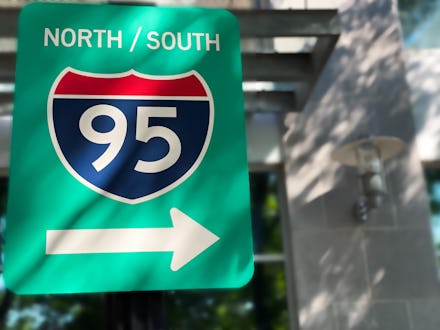People have been stuck on I-95 for damn near a whole day
A crash and snowstorm has left hundreds of motorists stranded in their cars overnight on a major highway outside of Washington, D.C.

Imagine merging onto the Interstate to make your way home, same as you do every day. The sun sets. It rises again. You are still on the Interstate. You’ve barely moved. Everything around you is the same, and there is no end in sight.
It sounds like a Stephen King novel, but it’s actually the nightmare that hundreds of drivers experienced on Interstate 95 in Virginia on Monday. A crash, rapid snowfall, and general lack of winter preparedness appears to have combined to create the perfect storm for a surreal situation that has trapped people in their cars overnight, with no relief in sight.
The majority of the backup appears to be happening on a 50-mile stretch of I-95 outside of Fredericksburg, Virginia, and Washington, D.C. Things started slowing down Monday evening, when a crash involving six tractor-trailers brought traffic to a halt. The crash itself didn’t cause any major injuries, but it did come at about the worst possible time. Snow was beginning to fall in the area, as the Atlantic coast was getting hit by the first major winter storm of the year. Parts of the East Coast received more than 1 foot of snowfall, and it wasn’t long before drivers on I-95 found themselves stuck in place.
Some people have reported being trapped in their cars for more than 24 hours, including spending as many as 18 hours stuck literally without moving. Hundreds of people were forced to spend the night in their cars, unable to get off the Interstate. Temperatures dropped below freezing overnight, forcing many to keep their cars running in order to stay warm. Drivers and passengers have been without food or water, with some fearing running out of fuel.
Those stuck in the traffic have reported minimal contact with authorities, who seem to be struggling to respond to the event. Josh Lederman, a reporter for NBC News, appeared on MSNBC’s Morning Joe from the front seat of his car while he waited for any sign of movement on the roadway. “This has been a pretty insane and fairly dystopian experience,” he said. “Nobody knows how long we are going to be here or how we’re going to get out.”
According to Lederman, some people turned off their cars in order to preserve gas because they were unsure how long they would be stuck. Others have gotten out of their car in order to walk their dog or let their kids stretch their legs. Lederman said that most of the communication about the situation has come from talking to others on the road and checking Twitter. Any official response has been nearly non-existent, he said: “I have not seen an emergency vehicle, a police car, or a plow.”
Virginia Sen. Tim Kaine (D) is among those stuck. On Twitter on Tuesday morning, he said that his normal, two-hour commute to Washington, D.C. had stretched into 19 hours and counting as he continued to be stuck behind several 18-wheelers. Kaine said a family driving up from Florida started handing out oranges to their fellow trapped travelers.
Jim DeFede, reporter for CBS4 News in Miami, said on Twitter that he has been in his car for over 24 hours. As of 10 a.m. local time, DeFede provided an update saying that he’d been stuck in the same place for “at least 17, almost 18 hours.” He relayed that local authorities finally provided messaging Tuesday morning indicating that support was on the way with supplies and efforts to get people off the road. “I am not reassured by this message,” DeFede said.
DeFede has good reason to be skeptical. It seems that the Virginia Department of Transportation has been woefully unprepared to respond to this event. While the agency issued a message Tuesday morning acknowledging that the situation is “unprecedented” and saying emergency services “continue to steadily move stopped trucks to make progress toward restoring lanes,” many people have felt abandoned by authorities. Lederman reported that people started trying to dig themselves out of the snow, but stopped when it was clear that no one was coming to help them.
What is happening on I-95 might seem like a fluke — a perfect confluence of events that has created a dramatic nightmare of a situation. It’s not. As our planet continues to warm, extreme weather events, like massive snowstorms, will become more common. Our infrastructure is woefully unequipped to survive these conditions, and our officials have done next to nothing to recognize that problem or do the work of preparing for future disasters. Situations like what is happening on I-95 will happen again if we are unprepared, unequipped, and unserious about addressing climate change.